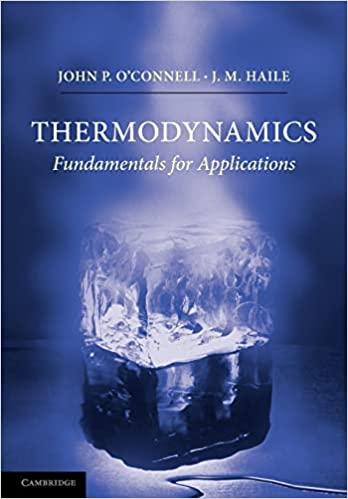Question
12 ton/h Glycerol will be heated from 18 C to 60 C by using 10 ton/h hot water at 80 C, in a shell-and-tube heat
12 ton/h Glycerol will be heated from 18 C to 60 C by using 10 ton/h hot water at 80 C, in a shell-and-tube heat exchanger. (Please don't send the answer handwritten.) 1. Find the thermophysical properties. 2. Design a shell and tube heat exchanger (with Process Design Procedure given below). 3. Calculate the pressure drop. The process design procedure steps for the shell and heat exchanger: Shell and tube heat exchangers are designed by trial and error calculations. The main steps of design following the Kern method are summarized as follows:
1. Obtain the required thermophysical properties of hot and cold fluids at the caloric temperature or arithmetic mean temperature. Calculate these properties at the caloric temperature if the variation of viscosity with temperature is large.
2. Perform energy balance and find out the heat duty (Q) of the exchanger.
3. Assume a reasonable value of the overall heat transfer coefficient (U_o,assm). The value of U_o,assm with respect to the process of hot and cold fluids can be taken from the books
4. Decide tentative number of shell and tube passes ( p n ). Determine the LMTD and the correction factor F_T. F_T normally should be greater than 0.75 for the steady operation of the exchangers. Otherwise, it is required to increase the number of passes to obtain higher F_T values.
5. Calculate heat transfer area (A) required: A = Q / (U_o,assm * LMTD*F_T)
6. Select tube material, and decide the tube diameter (ID= di , OD = do ), its Wall thickness (in terms of BWG or SWG) and tube length ( L ). Calculate the number of tubes (n_t=A/(pi*d_o*L)) required to provide the heat transfer area (A). Calculate tube side fluid velocity u=(4*m*(n_p/n_t)/(pi*-d_i^2). If u<1 ms, fix n_p so that re=(4*m*(n_p/n_t)/(pi*d_i,)> or equal to 10^4. Where, m, , and are the mass flow rate, density, and viscosity of tube side fluid. However, this is subject to allowable pressure drop in the tube side of the heat exchanger.
7. Decide the type of shell and tube exchanger (fixed tube sheet, U-tube, etc.). Select the tube pitch (PT), and determine the inside shell diameter (Ds ) that can accommodate the calculated number of tubes (nt ). Use the standard tube counts table for this purpose. Tube counts are available in standard textbooks
8. Assign fluid to the shell side or tube side. Select the type of baffle (segmental, doughnut etc.), its size (i.e. percentage cut, 25% baffles are widely used), spacing ( B ), and number. The baffle spacing is usually chosen to be within 0.2 Ds to Ds.
9. Determine the tube side film heat transfer coefficient (hi ) using the suitable form of the Sieder-Tate equation in laminar and turbulent flow regimes. Estimate the shell-side film heat transfer coefficient (ho ) from j_H = (h_o*D_e/k)*(((c*)/k)^(-1/3))*((/_w)^(-0.14)). You may consider, /_w=1
10. Select the outside tube (shell side) dirt factor (Rdo ) and inside tube (tube side) dirt factor (Rdi ). Calculate the overall heat transfer coefficient (Uo,cal ) based on the outside tube area (you may neglect the tube-wall resistance) including dirt factors: U_o,cal=[(1/h_o)+R_do+((A_0/A_i)*((d_0-d_i)/(2*k_w))+((A_0/A_i)*(1/h_i))+((A_0/A_i)*R_di)]^(-1)
11. If 0<(U_o,cal-U_o,assm/U_o,assm)<30% the next step (12). Otherwise, go to step 5, calculate the heat transfer area(A) required using U_o,cal and repeat the calculations starting from step 5. If the calculated shell side heat transfer coefficient (h_o) is too low, assume closer baffle spacing ( B ) close to 0.2 D_s and recalculate the shell side heat transfer coefficient. However, this is subject to allowable pressure drop across the heat exchanger.
12. Calculate % overdesign. Overdesign represents extra surface area provided beyond that required to compensate for fouling. The typical value of 10% or less is acceptable. % Overdesign=((A-A_reqd)/A_reqd)*100
13. Calculate the tube-side pressure drop (P_T) (i) pressure drop in the straight section of the tube (frictional loss) and (ii) return loss due to the change of direction of the fluid in a multi-pass exchanger. Total tube side pressure drop: P_T=P_t+P_rt
14. Calculate the shell-side pressure drop (P_S)(i) pressure drop for flow across the tube bundle (frictional loss) (P_S) and (ii) return loss due to change of direction of the fluid. Total shell side pressure drop: (P_S)=(P_s)+(P_rs) If the tube-side pressure drop exceeds the allowable pressure drop for the processing system, decrease the number of tubes passes or increase the number of tubes per pass. Go back to step 6 and repeat the calculation steps. If the shell-side pressure drop exceeds the allowable pressure drop, go back to step 7 and repeat the calculation steps.
Step by Step Solution
There are 3 Steps involved in it
Step: 1

Get Instant Access to Expert-Tailored Solutions
See step-by-step solutions with expert insights and AI powered tools for academic success
Step: 2

Step: 3

Ace Your Homework with AI
Get the answers you need in no time with our AI-driven, step-by-step assistance
Get Started


